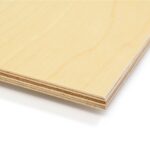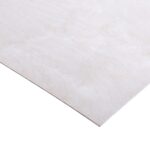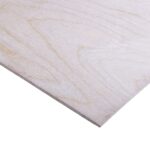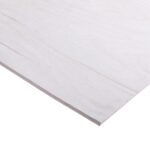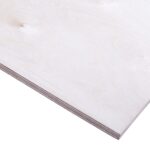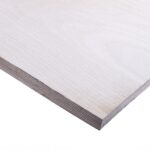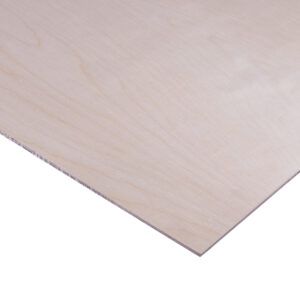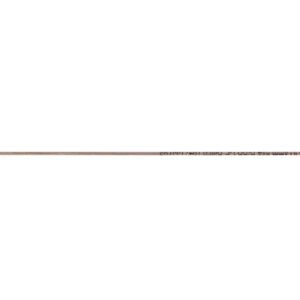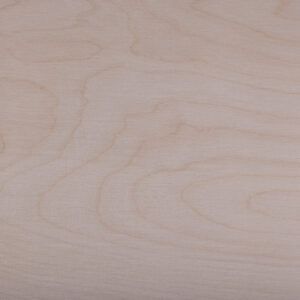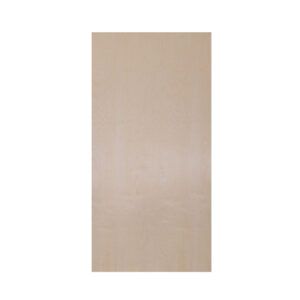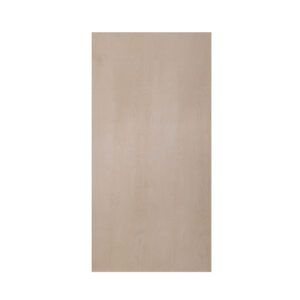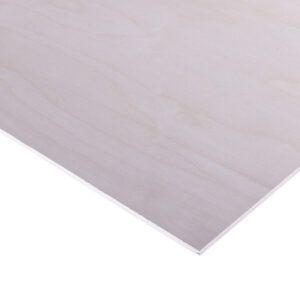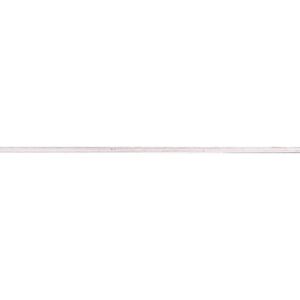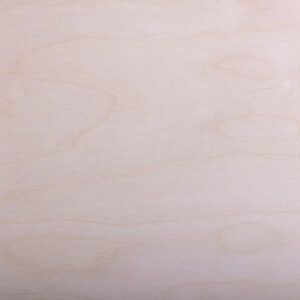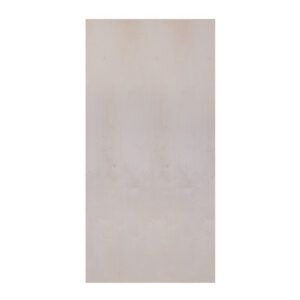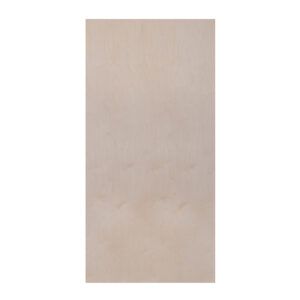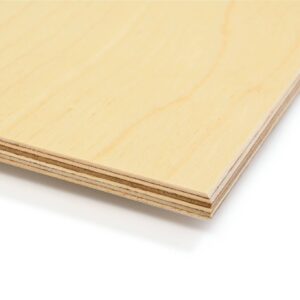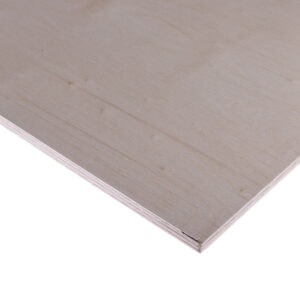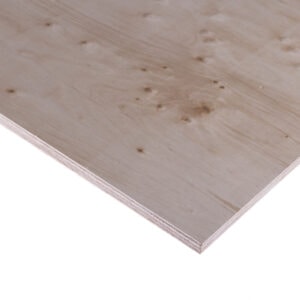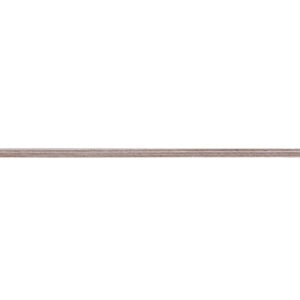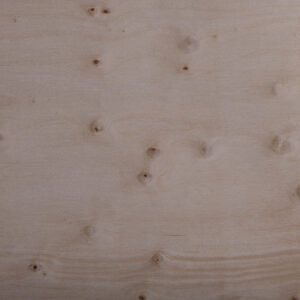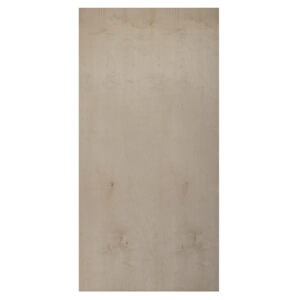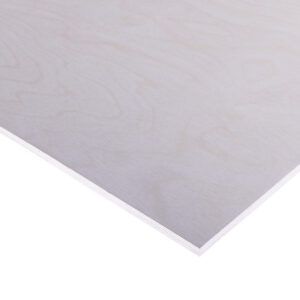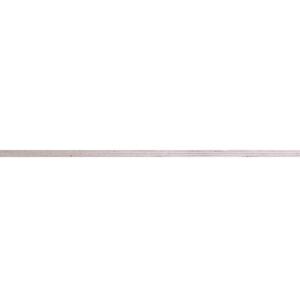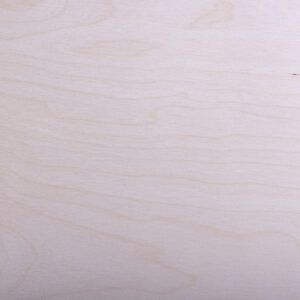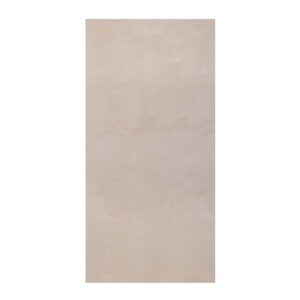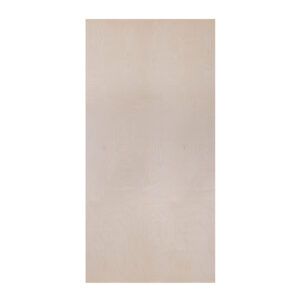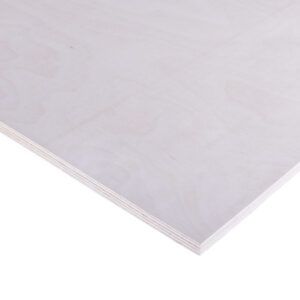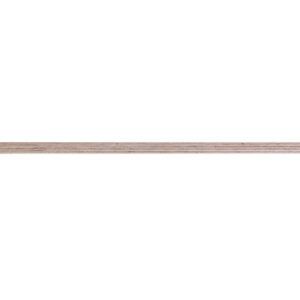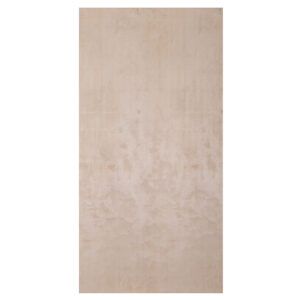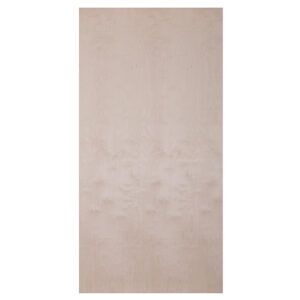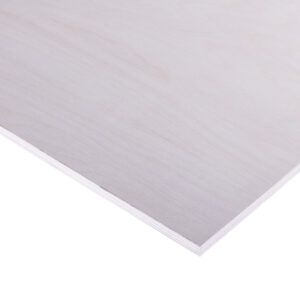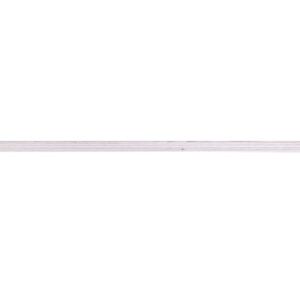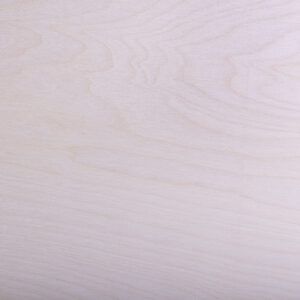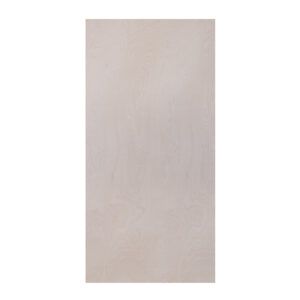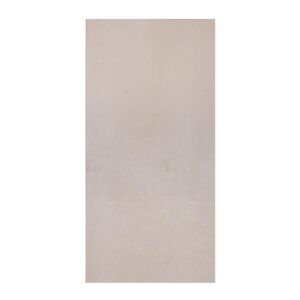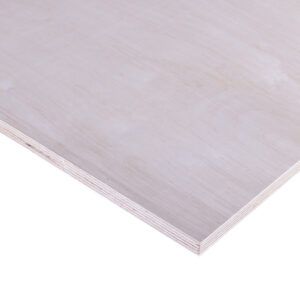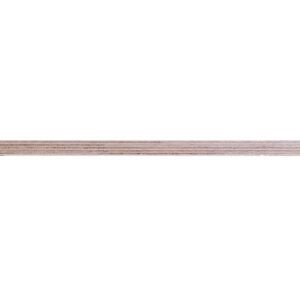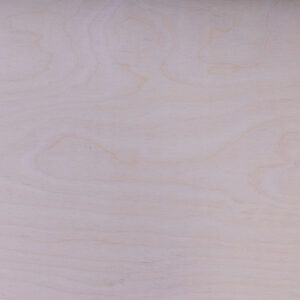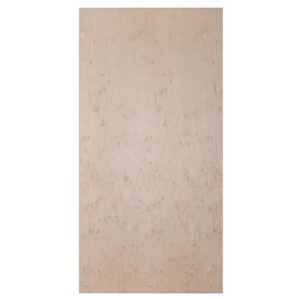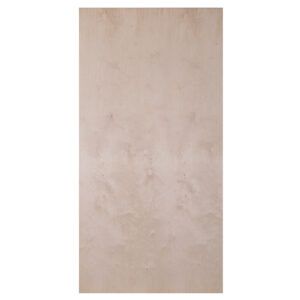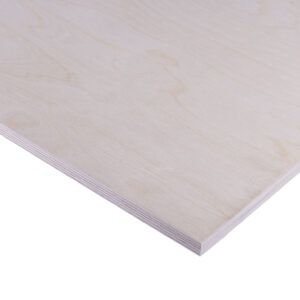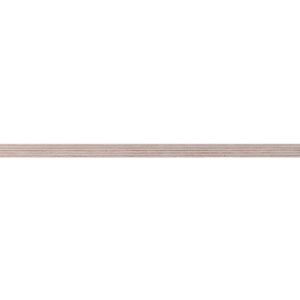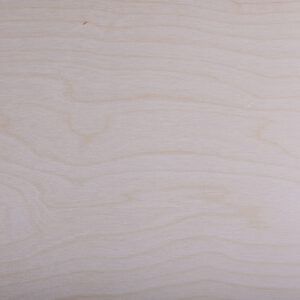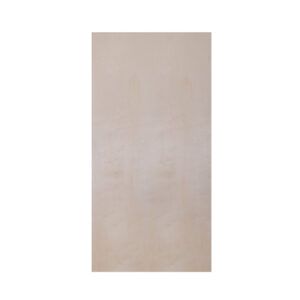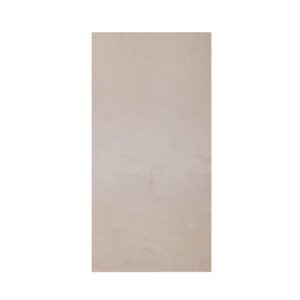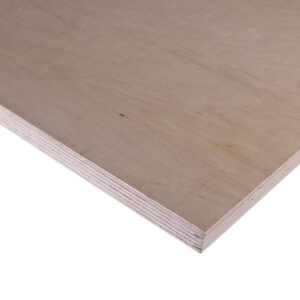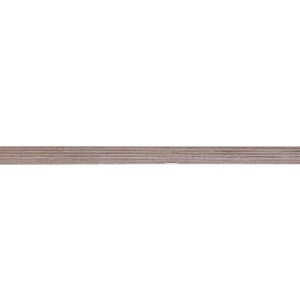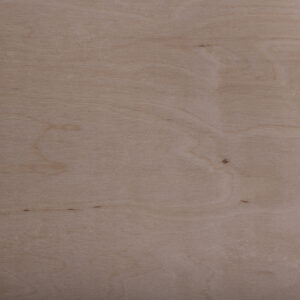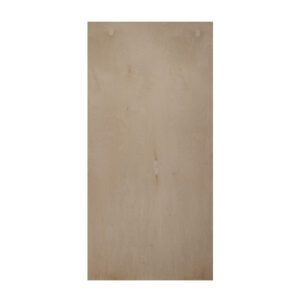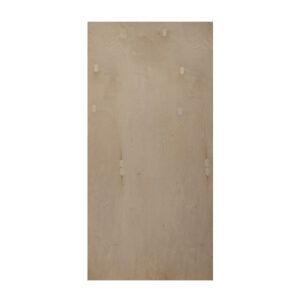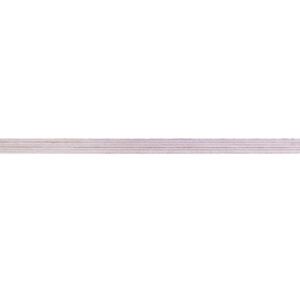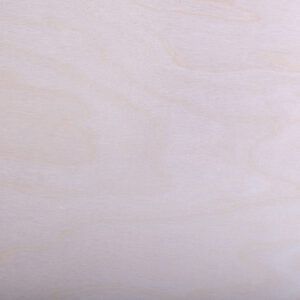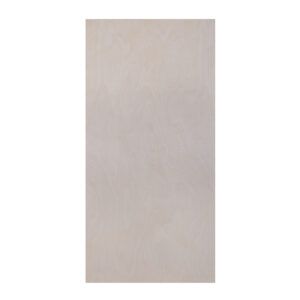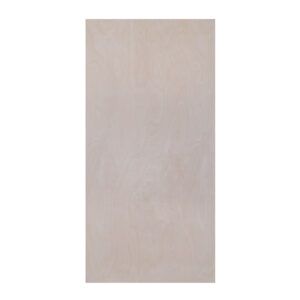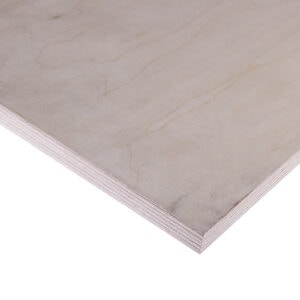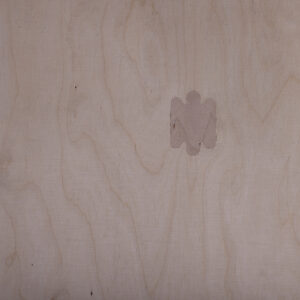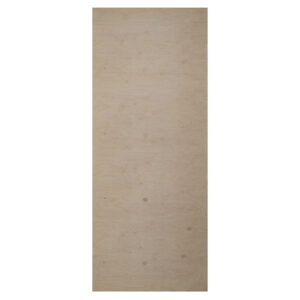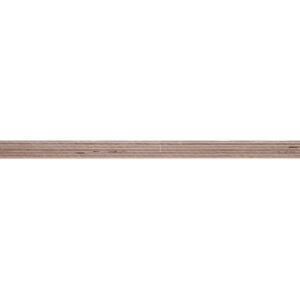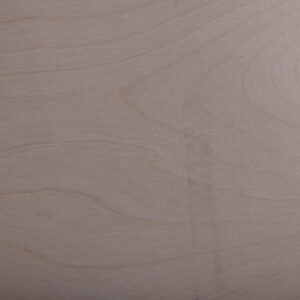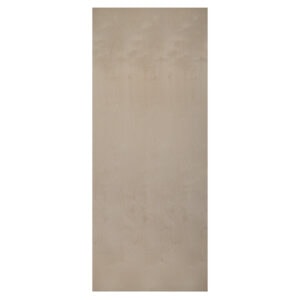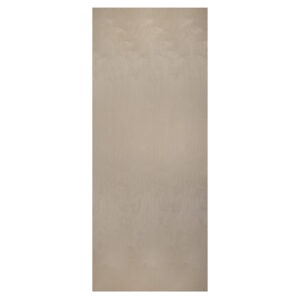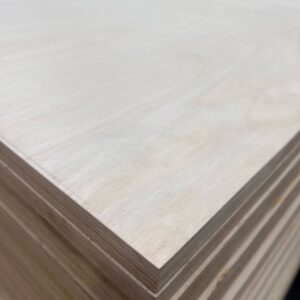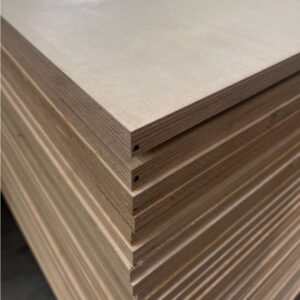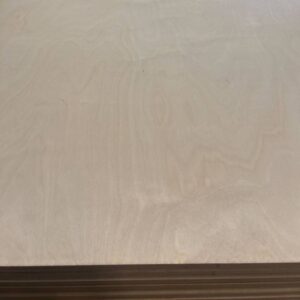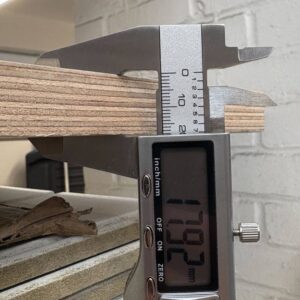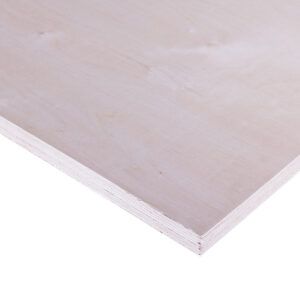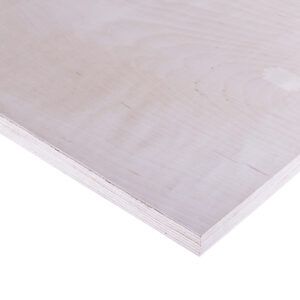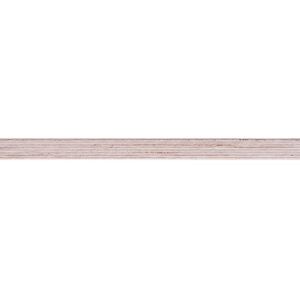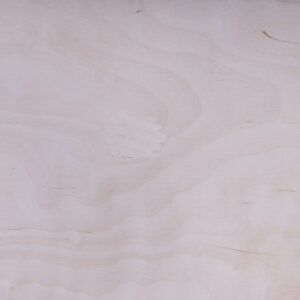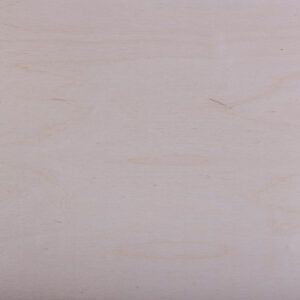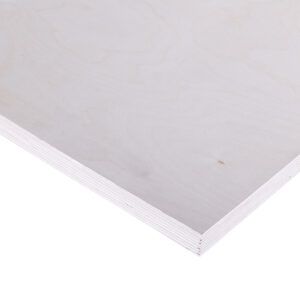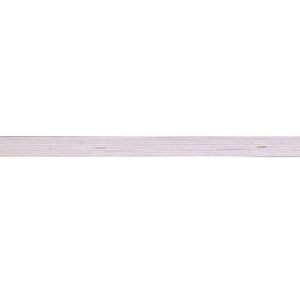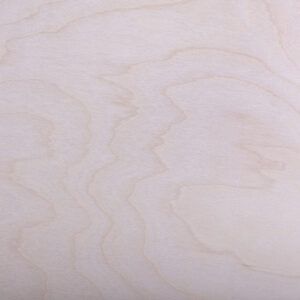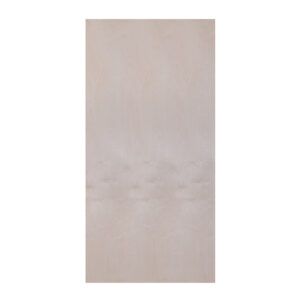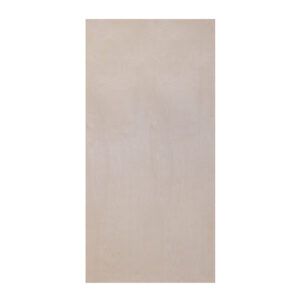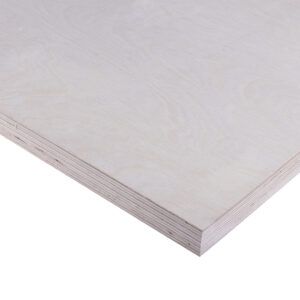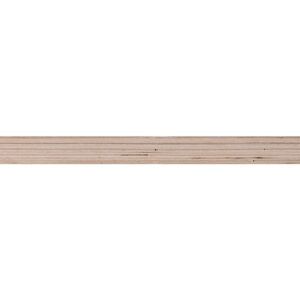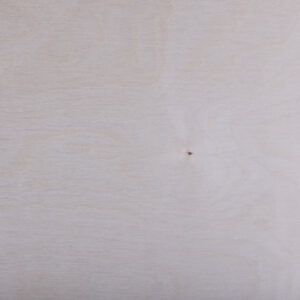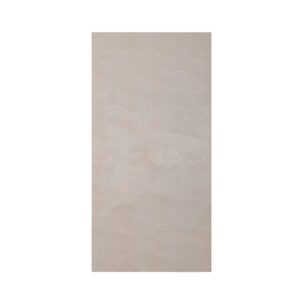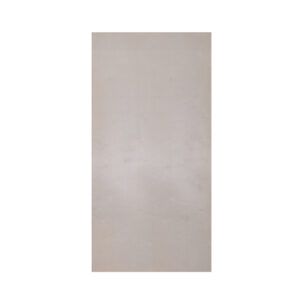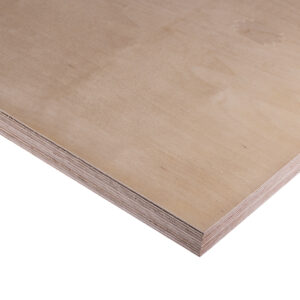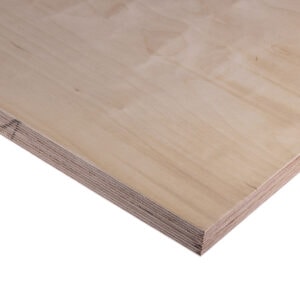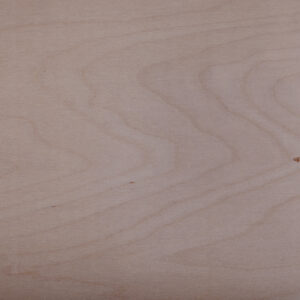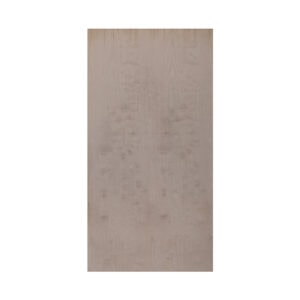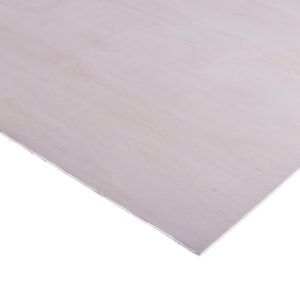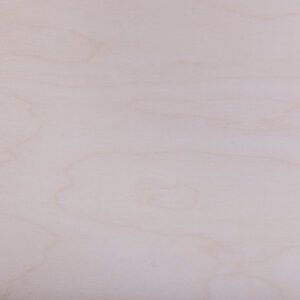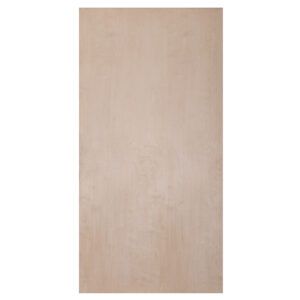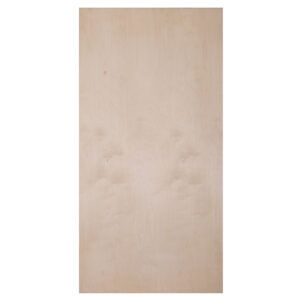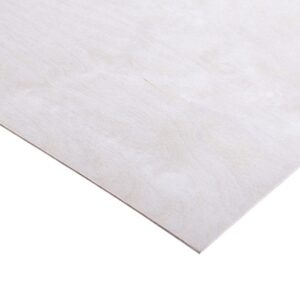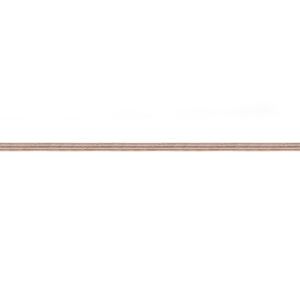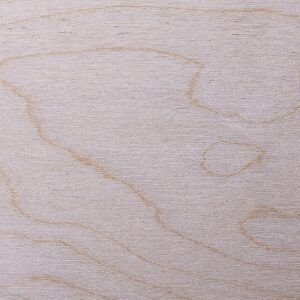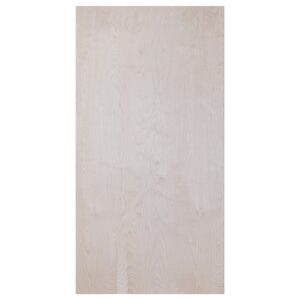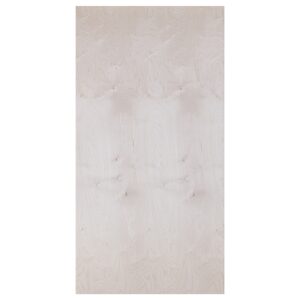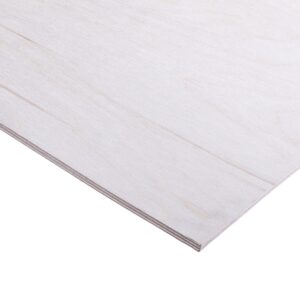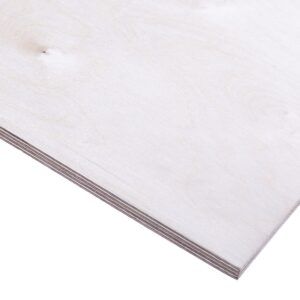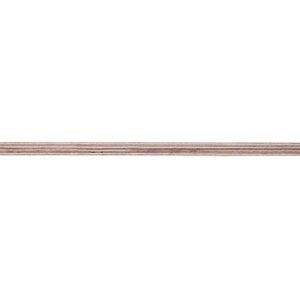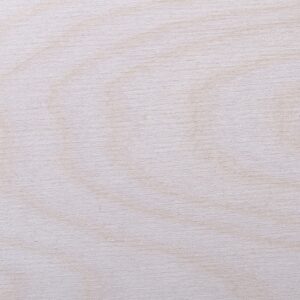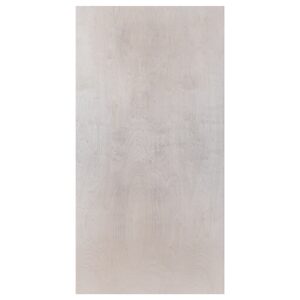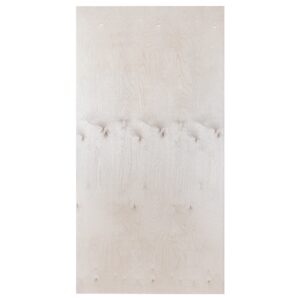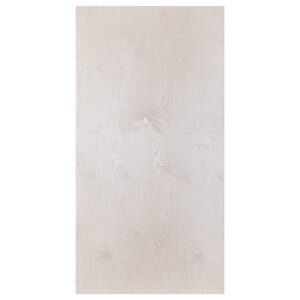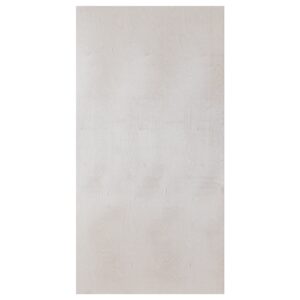Birch Plywood
At Sheets Materials Wholesale, we offer birch plywood throughout in a range of thicknesses, from 4mm to 30mm, with consistently graded B/BB and BB/BB sheets in standard sizes of 2440mm x 1220mm, 3050mm x 1220mm and 3050mm x 1525mm.
These products are FSC®-certified and available with quick UK delivery in 1 to 3 working days.
What Makes Our Birch Plywood Stand Out
- 100% Birch throughout – All veneers (face, back, and core) are cross-bonded birch, alternating at right angles to improve stability, strength, and flatness.
- High ply count – A typical 18mm sheet has about 13 plies, with thicker cores that deliver warp resistance and enhanced screw-holding capabilities.
- Clean-face veneers – B/BB grade gives you micro veneer layers on the face and back that are virtually defect-free (3-6 patched oval blemishes permitted on the back).
- Pre-finished surface – The surfaces are smooth, sanded veneer, meaning no need for further prepping before lacquering, staining, or painting.
- Engineered for structural use – The products are classified to BS EN 636 Class 3 for limited external exposure and structural interior/exterior use when sealed.
The Key Benefits of Using Our Birch Plywood
Strength, Durability, and Machinability
- A void-free core provides exceptional screw-holding power and clean cuts, making it ideal for finger joints, dovetails, or other complex joinery.
- The cross-bonded construction reduces shrinkage and prevents bowing and warping.
- The product machines cleanly, sands well, and performs well with routers and saws.
Aesthetic Appeal
- The clean, uniform face veneers with thick face/back layers present a beautiful finish that takes painting and staining well.
- The exposed edges showcase the stacked veneer look, which can be used as a decorative element in cabinetry and furniture.
Sustainability and Sourcing
Birch trees are relatively fast-growing and sustainably sourced in the Baltic region and northern Europe with FSC® certification. Specific listings clarify the FSC® grade, thickness, and origin.
Available Sizes, Classes, and Grades
Here’s what we provide:
Sizes
- You can get birch plywood in sizes that include 2440mm x 1220mm, 3050mm x 1220mm, and 1525 x 3050mm.
Classes
- BS EN 636 Class 3- Designed for structural use in classes 1, 2, and 3, both indoors and outdoors. This plywood has to be treated for external use. However, performance may decline if exposed to weather during construction.
- BS EN 636 Class 2- Designed for structural use in classes 1 and 2, for both interior and exterior projects. Needs protection from weather exposure during construction.
Grades
Available grades include B/BB and BB/BB. These grades correspond to specific face and core veneer quality classifications, suitable for a range of structural and non-structural applications depending on project requirements.
Here is a breakdown of what the grades mean:
- B (Highest quality)– Marked by a uniform light colour, it features a clean surface with no open splits or plugs. It features fewer pin knots and some colour inconsistencies.
- BB (Common commercial grade)– Has a uniform colour, though some may feature inconsistencies. It may have some splits/cracks, plugs, and pin knots.
- S (Improved version of BB)– Essentially a BB grade, but enhanced to balance strength and aesthetics.
- CP (General purpose)– Generally inconsistent in colour with more defects (stains and knots, and a lot of plugs).
- C (Lowest grade)– This is the commercial grade version with less colour consistency and may feature splits, stains, and larger knots.
Birch plywood grading is specified in a (front/back) format, and here are the common combinations you’ll often see:
- B/BB ✔ – Face veneer is B Grade, back veneer is BB grade.
- BB/BB ✔ – Face veneer is BB Grade, back veneer is BB grade.
- BB/CP ✔ – Face veneer is BB Grade, back veneer is CP grade.
- BB/WG ✔ – Face veneer is BB Grade, back veneer is WG grade.
- S+/BB ✗ – Face veneer is S+ Grade, back veneer is BB grade.
- CP/CP ✗ – Face veneer is CP Grade, back veneer is CP grade.
- C/C ✗ – Face veneer is C Grade, back veneer is C grade.
We currently stock the ones with a green checkmark. Note that our BB/CP and BB/WG birch plywood is available only on special order.
NOTE: While you may see mentions of a Grade A in places, it is unavailable in today’s market and essentially obsolete.
Thickness Variations
Birch plywood is offered in nominal thicknesses of:
NOTE: If you are looking for EPA TSCA Title VI and CARB Phase 2 plywood with low formaldehyde emissions, we stock options from Riga that meet those requirements.
We also stock Riga wood, Sezar, Paged, Artisan, Odek, etc., to maintain consistency across the catalogue.
Applications
These products work well for the following projects and scenarios:
- Cabinetry, furniture, wardrobes, and drawer components.
- Laser-cut or CNC crafting, especially on thin 4 to 6mm BB/BB panels.
- Feature walls, underlays for floors, and workshop fixtures
- Structural panels or concealed components that require consistency and strength.
Why Choose Our Birch Plywood?
| Feature | Sheets Material Wholesale Birch Plywood |
| All-birch core | ✔ Cross-bonded, void-free birch veneers |
| Face Quality | ✔ Clean-faced, B/BB, BB/BB, BB/CP, and BB/WG. |
| Sizes Available | ✔ 4mm to 30 mm, from 2440mm x 1220mm (8’ x 4’) up to 3050 mm x 1525mm (10’ x 5’) |
| Finish | ✔ Sanded, veneer surface ready for finishing |
| Certification | ✔ FSC®; Structural EN636 Class 3 |
| Lead Time | ✔ Friendly UK delivery and support within 1-3 days |
| Pricing | ✔ Premium but competitive with valid bulk discounts |
FAQs
-
Which grade is recommended for visible furniture surfaces?
For applications that need high visual quality, the B/BB panel is preferred. This grade features a high-quality veneer (grade B) with minimal defects, suitable for staining and clear finishes, and a reverse side (grade BB) with slightly more permissible imperfections.
-
How many plies are typically in 18mm birch plywood, and why is that important?
An 18mm birch plywood panel generally consists of 13 plies. The high ply count improves the dimensional stability, stiffness, and surface flatness. It holds screws better and resists warping or delamination.
-
Is Birch plywood suitable for exterior use?
Although classified under EN 636 Class 3, showing suitability for exterior applications, birch plywood is not naturally waterproof. To ensure durability in outdoor environments, seal all exposed edges and surfaces with a weather-resistant finish.
-
Can I get laser-cut panels or thin ply?
While we offer 4mm and 6mm BB/BB panels, special thin birch plywood (1.5 to 3mm) or flex-film guidelines are available via specialist suppliers.
-
How can I avoid low-quality ‘faux’ Baltic Birch?
First, confirm that it is ‘throughout’ birch, like what we provide, and not just birch-faced. Ask for specifics on ply count, country of origin, and physical inspection data (patch count, edge veneer consistency, etc.) to ensure high quality.
-
What is so special about birch plywood?
Birch plywood is made from multiple thin layers of birch veneer glued with alternating grain directions (cross-lamination), giving it exceptional strength, stability, and resistance to warping.
-
What are the disadvantages of birch plywood?
Birch plywood comes at a premium price compared to generic or softwood plywood. It is not fully waterproof, but its fine grain can lead to uneven staining without proper preparation, and the surface is more prone to scratches and dents than denser hardwoods. Outdoor applications demand sealing and regular maintenance to prevent rot and UV damage.
-
Which is better, MDF or birch?
The answer depends on your project:
- Birch plywood offers superior strength, stability, moisture resistance, and screw-holding capacity. It’s lighter, machines easily, and provides natural wood grain for exposed panels.
- MDF is more uniform, less expensive, and has a perfectly smooth surface that takes paint and veneer well. However, it is weaker under loads, heavier, prone to sagging, and more susceptible to moisture ingress.
For structural or visible woodwork, birch plywood beats MDF, whereas MDF presents a more budget-friendly choice for non-load-bearing, painted pieces.
-
Why is birch wood so expensive?
The premium you see on birch wood prices is due to birch’s desirable aesthetic and physical qualities. It is a slow-growing hardwood, resulting in tight, fine-grain veneers. High-grade birch (Baltic Birch) features void-free cores and thicker veneers, which work well for upscale furniture, cabinetry, and architectural applications.
-
How long does birch plywood last?
When kept in a controlled, dry indoor environment and properly finished, birch plywood can serve reliably for 30 to 35 years. Longevity relies on avoiding prolonged moisture exposure or keeping moisture out altogether for the entire lifespan of the product. Treatments can extend their life, but standard birch is best used in sheltered places.
Showing 1–32 of 36 results
-
4mm Birch Plywood Throughout B/BB 2440mm x 1220mm (8′ x 4′) FSC®
Birch plywood is made from only Birch veneers. Inner veneers are thicker than outer veneers, glued and laid up in alternating directions to the required thickness. It thus provides a superbly consistent strong panel with known engineering characteristics.
£39.41£47.29 Ex VATInc VAT Add to cart -
6mm Birch Plywood Throughout B/BB 2440mm x 1220mm (8′ x 4′) FSC®
Birch plywood is made from only Birch veneers. Inner veneers are thicker than outer veneers, glued and laid up in alternating directions to the required thickness. It thus provides a superbly consistent strong panel with known engineering characteristics.
Original price was: £56.63 Ex VAT (£67.96 Inc VAT).£54.93£65.92Current price is: £54.93 Ex VAT (£65.92 Inc VAT). Ex VATInc VAT Add to cart -
6.5mm Lacquered Birch Plywood Throughout BB/BB 2440mm x 1220mm (8′ x 4′)
High quality 6.5mm birch plywood with a factory applied decorative lacquer that’s saving your time. Ready-to-use lacquered birch plywood with smooth surface to work on your furniture, interior walls, ceilings and more applications.
£78.19£93.83 Ex VATInc VAT Add to cart -
Buy in Bulk & Save
33-64 65+ £55.06£66.07 £51.58£61.90 There are 1 more images9mm Birch Plywood Throughout BB/BB 2440mm x 1220mm (8′ x 4′) FSC®
Birch plywood is made from only Birch veneers of the same thickness, glued and laid up in alternating directions to the required thickness. It thus provides a superbly consistent strong panel with known engineering characteristics.
£57.96£69.55 Ex VATInc VAT Add to cart -
9mm Birch Plywood Throughout B/BB 2440mm x 1220mm (8′ x 4′) FSC®
Birch plywood is made from only Birch veneers. Inner veneers are thicker than outer veneers, glued and laid up in alternating directions to the required thickness. It thus provides a superbly consistent strong panel with known engineering characteristics.
£63.44£76.13 Ex VATInc VAT Add to cart -
9mm Lacquered Birch Plywood Throughout BB/BB 2440mm x 1220mm (8′ x 4′)
High quality 9mm birch plywood with a factory applied decorative lacquer that’s saving your time. Ready-to-use lacquered birch plywood with smooth surface to work on your furniture, interior walls, ceilings and more applications.
£87.49£104.99 Ex VATInc VAT Add to cart -
12mm Birch Plywood Throughout BB/BB 2440mm x 1220mm (8′ x 4′) FSC®
Birch plywood is made from only Birch veneers of the same thickness, glued and laid up in alternating directions to the required thickness. It thus provides a superbly consistent strong panel with known engineering characteristics.
Original price was: £67.10 Ex VAT (£80.52 Inc VAT).£65.49£78.59Current price is: £65.49 Ex VAT (£78.59 Inc VAT). Ex VATInc VAT Add to cart -
12mm Birch Plywood Throughout B/BB 2440mm x 1220mm (8′ x 4′) FSC®
Birch plywood is made from only Birch veneers. Inner veneers are thicker than outer veneers, glued and laid up in alternating directions to the required thickness. It thus provides a superbly consistent strong panel with known engineering characteristics.
£71.54£85.85 Ex VATInc VAT Add to cart -
12mm Lacquered Birch Plywood Throughout BB/BB 2440mm x 1220mm (8′ x 4′)
High quality 12mm birch plywood with a factory applied decorative lacquer that’s saving your time. Ready-to-use lacquered birch plywood with smooth surface to work on your furniture, interior walls, ceilings and more applications.
£98.43£118.12 Ex VATInc VAT Add to cart -
15mm Birch Plywood Throughout BB/BB 2440mm x 1220mm (8′ x 4′) FSC®
Birch plywood is made from only Birch veneers of the same thickness, glued and laid up in alternating directions to the required thickness. It thus provides a superbly consistent strong panel with known engineering characteristics.
Original price was: £85.38 Ex VAT (£102.46 Inc VAT).£81.99£98.39Current price is: £81.99 Ex VAT (£98.39 Inc VAT). Ex VATInc VAT Add to cart -
15mm Birch Plywood Throughout B/BB 2440mm x 1220mm (8′ x 4′) FSC®
Birch plywood is made from only Birch veneers. Inner veneers are thicker than outer veneers, glued and laid up in alternating directions to the required thickness. It thus provides a superbly consistent strong panel with known engineering characteristics.
£91.40£109.68 Ex VATInc VAT Add to cart -
15mm Lacquered Birch Plywood Throughout BB/BB 2440mm x 1220mm (8′ x 4′)
High quality 15mm birch plywood with a factory applied decorative lacquer that’s saving your time. Ready-to-use lacquered birch plywood with smooth surface to work on your furniture, interior walls, ceilings and more applications.
£112.74£135.29 Ex VATInc VAT Add to cart -
18mm Birch Plywood Throughout BB/BB 2440mm x 1220mm (8′ x 4′) FSC®
Birch plywood is made from only Birch veneers of the same thickness, glued and laid up in alternating directions to the required thickness. It thus provides a superbly consistent strong panel with known engineering characteristics.
£95.05£114.06 Ex VATInc VAT Add to cart -
18mm Birch Plywood Throughout B/BB 2440mm x 1220mm (8′ x 4′) FSC®
Birch plywood is made from only Birch veneers. Inner veneers are thicker than outer veneers, glued and laid up in alternating directions to the required thickness. It thus provides a superbly consistent strong panel with known engineering characteristics.
£102.60£123.12 Ex VATInc VAT Add to cart -
Buy in Bulk & Save
18-34 35+ £131.05£157.26 £127.35£152.82 There are 3 more images18mm Birch Plywood Throughout BB/BB 1220mm x 3050mm (4′ x 10′) FSC®
18mm Short Grain Birch plywood is made from only 18mm Birch veneers of the same thickness, glued and laid up in alternating directions to the required thickness. It thus provides a superbly consistent strong panel with known engineering characteristics.
£134.76£161.71 Ex VATInc VAT Add to cart -
18mm Birch Plywood Throughout B/BB 3050mm x 1220mm (10′ x 4′) FSC®
Birch Large plywood is made from only Birch veneers. Inner veneers are thicker than outer veneers, glued and laid up in alternating directions to the required thickness. It thus provides a superbly consistent strong panel with known engineering characteristics.
Original price was: £158.91 Ex VAT (£190.69 Inc VAT).£148.35£178.02Current price is: £148.35 Ex VAT (£178.02 Inc VAT). Ex VATInc VAT Add to cart -
18mm Oversanded Birch Plywood Throughout B/BB 3050mm x 1220mm (10′ x 4′) FSC®
Birch Large plywood is made from only Birch veneers. Inner veneers are thicker than outer veneers, glued and laid up in alternating directions to the required thickness. It thus provides a superbly consistent strong panel with known engineering characteristics.
Original price was: £158.91 Ex VAT (£190.69 Inc VAT).£93.75£112.50Current price is: £93.75 Ex VAT (£112.50 Inc VAT). Ex VATInc VAT Add to cart -
18mm Birch Plywood Throughout BB/BB 1525mm x 3050mm (5′ x 10′) FSC®
18mm Short Grain Birch plywood is made from only 18mm Birch veneers of the same thickness, glued and laid up in alternating directions to the required thickness. It thus provides a superbly consistent strong panel with known engineering characteristics.
£164.53£197.44 Ex VATInc VAT Add to cart -
18mm Lacquered Birch Plywood Throughout BB/BB 2440mm x 1220mm (8′ x 4′)
High quality 18mm birch plywood with a factory applied decorative lacquer that’s saving your time. Ready-to-use lacquered birch plywood with smooth surface to work on your furniture, interior walls, ceilings and more applications.
£127.60£153.12 Ex VATInc VAT Add to cart -
Buy in Bulk & Save
12-24 25+ £120.99£145.19 £113.35£136.02 There are 2 more images24mm Birch Plywood Throughout BB/BB 2440mm x 1220mm (8′ x 4′) FSC®
Birch plywood is made from only Birch veneers of the same thickness, glued and laid up in alternating directions to the required thickness. It thus provides a superbly consistent strong panel with known engineering characteristics.
£127.36£152.83 Ex VATInc VAT Add to cart -
24mm Birch Plywood Throughout B/BB 2440mm x 1220mm (8′ x 4′) FSC®
Birch plywood is made from only Birch veneers. Inner veneers are thinner than outer veneers, glued and laid up in alternating directions to the required thickness. It thus provides a superbly consistent strong panel with known engineering characteristics.
£133.69£160.43 Ex VATInc VAT Add to cart -
24mm Birch Plywood Throughout B/BB 3050mm x 1220mm (10′ x 4′) FSC®
Birch Large plywood is made from only Birch veneers. Inner veneers are thicker than outer veneers, glued and laid up in alternating directions to the required thickness. It thus provides a superbly consistent strong panel with known engineering characteristics.
£187.57£225.08 Ex VATInc VAT Add to cart -
24mm Lacquered Birch Plywood Throughout BB/BB 2440mm x 1220mm (8′ x 4′)
High quality 24mm birch plywood with a factory applied decorative lacquer that’s saving your time. Ready-to-use lacquered birch plywood with smooth surface to work on your furniture, interior walls, ceilings and more applications.
£170.71£204.85 Ex VATInc VAT Add to cart -
30mm Birch Plywood Throughout B/BB 2440mm x 1220mm (8′ x 4′) FSC®
Birch plywood is made from only Birch veneers. Inner veneers are thicker than outer veneers, glued and laid up in alternating directions to the required thickness. It thus provides a superbly consistent strong panel with known engineering characteristics.
Original price was: £195.14 Ex VAT (£234.17 Inc VAT).£191.16£229.39Current price is: £191.16 Ex VAT (£229.39 Inc VAT). Ex VATInc VAT Add to cart -
30mm Birch Plywood Throughout BB/BB 2440mm x 1220mm (8′ x 4′) FSC®
30mm Birch plywood is made from only Birch veneers of the same thickness, glued and laid up in alternating directions to the required thickness. It thus provides a superbly consistent strong panel with known engineering characteristics.
Original price was: £174.56 Ex VAT (£209.47 Inc VAT).£170.29£204.35Current price is: £170.29 Ex VAT (£204.35 Inc VAT). Ex VATInc VAT Add to cart -
4mm Birch Plywood Throughout BB/BB 2440mm x 1220mm (8′ x 4′) FSC®
Birch plywood is made from only Birch veneers of the same thickness, glued and laid up in alternating directions to the required thickness. It thus provides a superbly consistent strong panel with known engineering characteristics.
POA Get a quote -
4mm Birch Plywood Throughout BB/CP 2440mm x 1220mm (8′ x 4′) FSC®
Birch plywood is made from only Birch veneers of the same thickness, glued and laid up in alternating directions to the required thickness. It thus provides a superbly consistent strong panel with known engineering characteristics.
POA Get a quote -
6mm Birch Plywood Throughout BB/CP 2440mm x 1220mm (8′ x 4′) FSC®
Birch plywood is made from only Birch veneers of the same thickness, glued and laid up in alternating directions to the required thickness. It thus provides a superbly consistent strong panel with known engineering characteristics.
POA Get a quote -
6mm Birch Plywood Throughout BB/BB 2440mm x 1220mm (8′ x 4′) FSC®
Birch plywood is made from only Birch veneers of the same thickness, glued and laid up in alternating directions to the required thickness. It thus provides a superbly consistent strong panel with known engineering characteristics.
POA Get a quote -
9mm Birch Plywood Throughout BB/CP 2440mm x 1220mm (8′ x 4′) FSC®
Birch plywood is made from only Birch veneers of the same thickness, glued and laid up in alternating directions to the required thickness. It thus provides a superbly consistent strong panel with known engineering characteristics.
POA Get a quote -
12mm Birch Plywood Throughout BB/CP 2440mm x 1220mm (8′ x 4′) FSC®
Birch plywood is made from only Birch veneers of the same thickness, glued and laid up in alternating directions to the required thickness. It thus provides a superbly consistent strong panel with known engineering characteristics.
POA Get a quote -
15mm Birch Plywood Throughout BB/CP 2440mm x 1220mm (8′ x 4′) FSC®
Birch plywood is made from only Birch veneers of the same thickness, glued and laid up in alternating directions to the required thickness. It thus provides a superbly consistent strong panel with known engineering characteristics.
POA Get a quote
